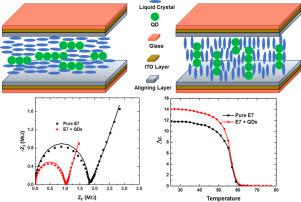Journal of Molecular Liquids ( IF 5.3 ) Pub Date : 2020-09-24 , DOI: 10.1016/j.molliq.2020.114373 Zahra Seidalilir , Ehsan Soheyli , Mohammad Sabaeian , Reza Sahraei

|
The doping effects of Ni-doped ZnCdS/ZnS (Ni:ZnCdS/ZnS) core/shell quantum dots (QDs) on the electrochemical and electro-optical properties of a nematic liquid crystal (LC) system were demonstrated. The impedance response of pure and QD-dispersed nematic LCs was investigated in the frequency range of 0.1 Hz–100 kHz. By fitting a suitable equivalent electric circuit model to the experimental data, it was concluded that the QDs doping noticeably increases the electrical conductivity and charge-capacitance of nematic LC. The ionic mobility and diffusion coefficient are strictly dependent on the QD concentration and the amount of these parameters decreases when 0.25 wt% of the QDs is introduced to the nematic LC, and then increases on further addition of the QDs. This phenomenon is due to the competition between the generated ionic impurities during assembling and the ion-capturing effect of the QDs. The viscosity of nematic LC increased at first and then decreased with increasing concentration of the QDs. Dielectric permittivity of nematic LC samples was also measured at different temperatures. The QD-doped samples exhibited higher permittivity compared to pure nematic LC. The dielectric anisotropy exhibited an increasing trend upon the addition of the QDs up to 0.75 wt% and decreased with further adding QDs. The dielectric results indicated that the nematic phase LC induced self-assembly on QDs to form one-dimensional arrays along the nematic director. Moreover, QDs dispersed in the LC mixture trapped ionic impurities, suppressed the ionic screen effect, and strengthened the electric field in the nematic LC bulk. Therefore, the QDs doping decreased the threshold voltage of the nematic LC cell. The estimated field-off response time initially increased and then decreased with an increase in the concentration of QDs. These results suggest that Ni:ZnCdS/ZnS QDs doped into an LC system can be beneficial for both the display industry as well as circuits working at the highly sensitive system.
中文翻译:

Ni:ZnCdS / ZnS核/壳量子点掺杂的向列液晶的电化学和电光性能增强
证明了掺Ni的ZnCdS / ZnS(Ni:ZnCdS / ZnS)核/壳量子点(QDs)对向列液晶(LC)体系的电化学和电光性质的掺杂作用。在0.1 Hz–100 kHz的频率范围内,研究了纯的和QD分散的向列型LC的阻抗响应。通过将合适的等效电路模型拟合到实验数据,可以得出结论:掺杂的QD显着增加了向列LC的电导率和电荷电容。离子迁移率和扩散系数严格取决于QD浓度,并且当将0.25 wt%的QD引入向列型LC时,这些参数的数量会减少,然后随着QD的进一步添加而增加。这种现象是由于组装过程中产生的离子杂质与QD的离子捕获效应之间的竞争所致。向列液相色谱的粘度首先增加,然后随着量子点浓度的增加而降低。向列型LC样品的介电常数也在不同温度下测量。与纯向列型LC相比,掺QD的样品表现出更高的介电常数。当添加高达0.75wt%的QD时,介电各向异性表现出增加的趋势,并且随着进一步添加QD而减小。介电结果表明,向列相LC诱导了量子点上的自组装,沿着向列指向矢形成一维阵列。此外,分散在LC混合物中的QD捕获了离子杂质,从而抑制了离子屏蔽效应,并增强了向列LC本体中的电场。因此,QD掺杂降低了向列LC电池的阈值电压。估计的场外响应时间最初随着QD浓度的增加而增加,然后减少。这些结果表明,掺杂到LC系统中的Ni:ZnCdS / ZnS QD对显示行业以及在高灵敏度系统中工作的电路都有利。











































 京公网安备 11010802027423号
京公网安备 11010802027423号